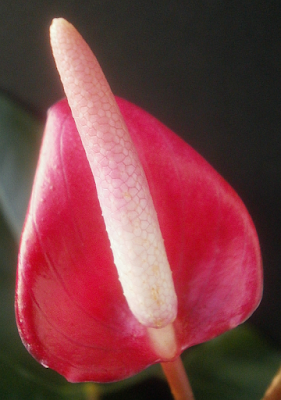The husband's office was a magical place this summer and fall, apparently: the Polyscias fruticosa bloomed for the first time in June; the Anthurium schlechtendalii bloomed in October, and now the Dracaena 'Indonesian Tracker' in November.1 I had no reason to think that any of them would ever bloom, so it's neat that they all have, and downright peculiar that they did so within a few months of one another.
There is, of course, a smell. It's definitely an improvement on the vinegar / garbage can smell of the Anthurium,2 which is lucky for us, since it's also really strong. It's a bit like I remember the Dracaena surculosa flowers smelling, though some of that might be because the flowers look a lot the same and my brain is lazy.3 I described D. surculosa as smelling like an intense generic floral smell, with maybe a note of a chemical/solvent-type thing in there.
I would describe the smell of 'Indonesian Tracker' similarly, up to a point: the solvent/chemical note is still there. In fact, in the early afternoon, it's all that's there, and it's not pleasant. But a heavy floral scent takes over pretty shortly thereafter. I couldn't figure out specifically what it smells like. It's sort of especially hard to figure out in this case, because I only get about ten seconds to try to name it before my nose adapts and I can't smell it anymore, plus I can only identify a few flowers by scent in the first place so my vocabulary's pretty limited,4 and worst of all, it changes during the course of the night, but it reminds me a little of the Murraya paniculata in the early evening, and of carnations in the late evening.
There's also a sweet note to the fragrance -- on Halloween night when the flowers first began to open, I was working in my office and kept getting distracted by a new smell that was definitely not the Hoya lacunosa,5 something that brought to mind white birthday cake. This is hard to detect when closer to the flowers, because the floral smell overwhelms it, but it seems to be the component that travels the best. The only thing I can think of that smells at all similar to this part is Duranta.
I don't know much about 'Indonesian Tracker.' Asiatica Nursery (where I bought my plant, in 2008) presented it as a Dracaena hybrid, but they've since gone out of business, so I can't ask them about it. Logee's sells 'Indonesian Tracker,' and their information page for 'Indonesian Tracker' also identifies it as a hybrid but doesn't go any further than that. I'd really like to know what it's a hybrid of, but nobody seems to know or care, and searching the internet mostly brings up people selling it or my own posts mentioning it. No patent, even. So I'll guess D. fragrans (for the long leaves, upright habit, and sweet-smelling blooms) x D. surculosa (for the spots and whorls of leaves): if you stretched a D. surculosa leaf out to D. fragrans length, and the spots stretched along with it, you'd get something that resembled 'Indonesian Tracker.' I doubt that's correct, but it's my guess.
As a houseplant, it's a little underwhelming, in the usual Dracaena ways: it gets leggy over time, it gets taller but not wider. That sort of thing. I wouldn't say it's bad, though. I mean, if nothing else, it's very easy, and it grows so slowly that you'll have it for a few years before the legginess becomes a problem.
With some Dracaenas, the appearance of flowers would mean that the stem is about to branch; I suppose we'll find out if 'Indonesian Tracker' is one of those.
-
2 I don't remember there being a smell with the Polyscias.
3 Dracaena flowers all look like this to some degree or another. The color varies slightly, but the basic construction is similar: long, narrow white petals, with equally long white stamens and one (?) pistil in the center. (Examples:
Dracaena marginata, Dracaena fragrans, Dracaena surculosa var. punctata, Dracaena sanderiana, Dracaena thalioides.)
Also very similar: Sansevieria flowers. (e.g.) Sansevieria and Dracaena are pretty closely related -- part of the subfamily Nolinoideae, along with Aspidistras (whose flowers look nothing like this) and Beaucarnea (ditto except for being approximately the same color) -- so this shouldn't surprise me as much as it does.
4 I can sort of imagine the smells of Gardenia, marigolds, roses, lilacs, lily-of-the-valley, geraniums, petunias, peonies, Sansevieria, chrysanthemums, Eucharis, carnations, and Murraya paniculata, at least well enough to decide whether something smells like them. I can't really conjure up jasmine, hyacinths, tuberose, lilies, iris, heliotropes, lavender, alyssum, freesias, orange blossoms, or sweet peas, though I'm certain I've smelled all of them at one time or another.
5 (which is what's usually responsible for pleasant smells that suddenly appear after dark)










.png)





